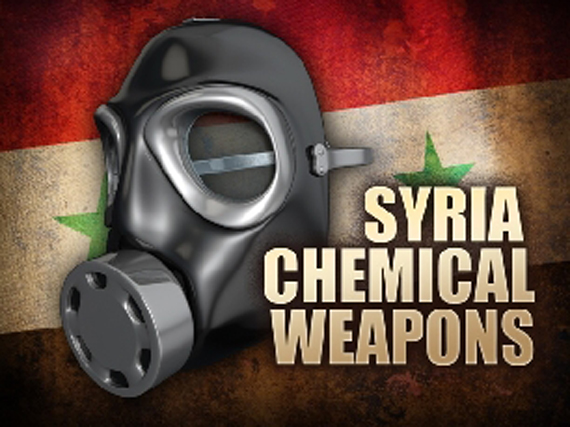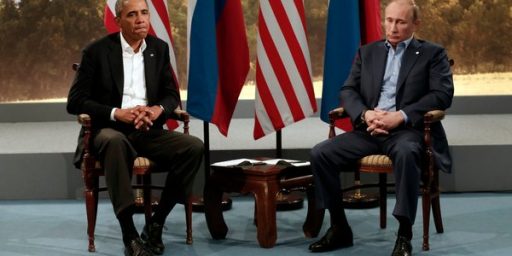Syria Mission Creep
Is U.S. planning against Syria moving beyond just chemical weapons?
Well, so much for that talk last week that the United States was merely planning to lob a few Tomahawk cruise missiles at Syria:
On Wednesday, administration officials spent a second day exhorting lawmakers to approve the resolution, arguing that while the strike is aimed specifically at the government’s use of chemical weapons, it also would degrade Mr. Assad’s overall military strength—suggesting a broader purpose.
“Is there a downstream collateral benefit to what will happen in terms of the enforcement of the chemical weapons effort? The answer is yes, it will degrade his military capacity,” Secretary of State John Kerry told the House Foreign Affairs Committee.
Taking out Mr. Assad’s helicopters, for example, would have a significant impact. The regime uses them to transport troops and supplies. Without them, Mr. Assad would have to rely more heavily on ground convoys, which are easier to attack.
The White House declined to comment on the possible use of bombers or any other targeting changes. A senior administration official said the scope of targets never had been limited to Syria’s chemical weapons.
The Pentagon’s new planning stems from Mr. Assad moving equipment, including Russian-made helicopters, to bases around the country while the U.S. debates, a change that could require the Pentagon to use many more Tomahawk cruise missiles and other types of munitions than initially envisioned.
Moreover, U.S. officials say, Mr. Assad has moved aircraft and other equipment into hardened bunkers and shelters. In some cases, destroying these hardened targets, officials say, could require the use of multiple Tomahawks.
The Navy destroyers in the Mediterranean carry about 40 Tomahawks each. Air Force bombers could carry dozens more munitions, potentially allowing the U.S. to carry out follow-on strikes if the first wave doesn’t destroy the targets.
Among options available are B-52 bombers, which can carry cruise missiles; low-flying B1s that are based in Qatar and carry long-range, air-to-surface missiles; and B-2 stealth bombers, which are based in Missouri and carry heavy guided bombs.
Some of this, of course, is the inevitable result of the fact that U.S. action against Syria is being delayed by several weeks at least while Congress weighs on. Nonetheless, one does wonder if the Administration is using the excuse of “degrading Syria’s chemical weapons abilities” to put its thumb on the scale on the side of the rebels in the civil war. For reasons that have been discussed at length already, it’s not at all clear that a post-Assad Syria would be any more in America’s national interests than the current regime. Indeed, it’s possible it could be worse. For that reason alone, stepping up the missing like this should raise some serious concerns.
The question, of course, is what news like this might have on the fate of the Syria AUMF in Congress. In their appearances before the relevant House and Senate this week, Secretaries Hagel and Kerry, along with JCS Chairman Dempsey, have emphasized repeatedly that the Administration is seeking authorization to use for for a specific, limited, purpose. While there has been commentary along the way that such strikes could have an impact on the Assad regime’s ability to strike against the rebels with conventional forces, all three have made clear that the President was not seeking the authority to intervene in the Syrian civil war on one side or the other. News of this type of expanded military planning, though, seems to belie those comments significantly and suggest that a strike would see the United States acting as air support for the rebels. To the extent that there are members of the House and Senate already expressing doubt about the wisdom of this mission, such news could cause problems for the chances that the resolution will ultimately pass.







The vote count is not looking good as it is.
http://www.washingtonpost.com/blogs/the-fix/wp/2013/09/05/prospects-for-syria-resolution-dimming-in-house/
Prediction: There will be “boots on the ground”. Ironically enough, I hope I’m wrong.
I lost trust in the National Security community way back in the build up to the Iraq War. This is why we need to stay totally out of it. To me, we are getting sucked into (aided and abetted by the government in Israel) a confrontation with Iran. That is the ultimate mission creep.
Besides, as we have said many times before on this site: there are no friends in this sectarian conflict.
Mission creep? But that never happens:)
Would it be wrong to assume that boots are already on the ground, either in the form of SF operators or spooks?
Apparently we’re taking targeting orders from the Syrian opposition military commanders:
http://www.washingtonpost.com/opinions/david-ignatius-syria-nears-a-turning-point/2013/09/04/e259ba1e-15b4-11e3-a2ec-b47e45e6f8ef_story.html
@CB:
It’s a fairly open secret that the CIA has been on the ground in contact with rebels for some time. Supposedly, they’ve been operating out of Turkey, but it’s hard to believe that they have not crossed the border.
Also, my understanding is that it’s rather common for any military operation such as the one Obama is contemplating to be preceded by the insertion of SF troops for the purpose of reconnaissance and target identification.
Morally, the use of WMD is reprehensible and should be punished. On the other hand, if the Muslim world is busy killing each other then they won’t have time to focus on killing Christians and Jews.
Um….Syria is the mission creep. Ten years ago, we invaded a country because they might be a terrorist sponsor and might have WMD to use. So when Syria, a state sponsor of terror, actually uses chemical weapons….it makes total sense we would do nothing.
I don’t think the administration is signalling any sort of mission creep here.
They want to inflict consequences for use of chemical weapons without putting boots on the ground.
Ideally, we would bomb the chemical weapons stockpiles, but then we would risk releasing chemicals on civilians. We’re left with military targets, which with varying degrees of relationship to the chemical attacks, but would constitute the most humane military consequence available.
The risk of mission creep comes from the possibility that Syria or its allies respond to any action by attacking U.S. interests or escalating attacks on Syrian civilians.
@CB:
I’m not counting those — it’s safe to assume that we have SF &/or “spooks” everywhere on the planet. Roughly like predicting that Gravity will still be in effect this time next year.
This “limited” war strategy has been tried time and again and results in anything but. Maybe the best thing to do is just have a rule if you go in there are no limits. Then they might just decide it is not worth the price. While I don’t oppose the idea of sending in advisers, I would want to know who we are advising and why. I am not impressed with either side here.
“requiring a full retaliatory response” (Kennedy, 1962)
“You want a war you can’t win?” (Colonel Troutman)
Of course there will be. Because chemical weapons aren’t a serious threat to bring about this sort of response. There is always the public face given….then the real story. I wish people would stop refering to Chemical Weapons as WMD as if they are in some special class of destruction above “conventional” high explosives. The speed and mobilitiy of even moderately equipped forces today make their employement foolish. Great care has to be given to where one detonates the shells. Can’t be downwind… what happens when the enemy advances? You can’t use it close to your own postion. You can’t shell a position with chemicals then advance on it….the target can’t have access to masks and MOP gear. In other words, they only fit the combat tactics of WWI which is why no military has used them in combat since. At best they are a one-trick pony against civilian populations…who, for that matter, can be geared up after the first attack. Simpler to just blow them up if despotism is your game.
@PD Shaw:
This! Which is the problem of using violence to solve this sort of situation — the only way it actually works is if you are willing to escalate to match the threat. Period. Hence the problem with the “red line” model to begin with.
Whether or not it has to come to it, to make this work, we need to be prepared for boots-on-the-ground or we shouldn’t do it.